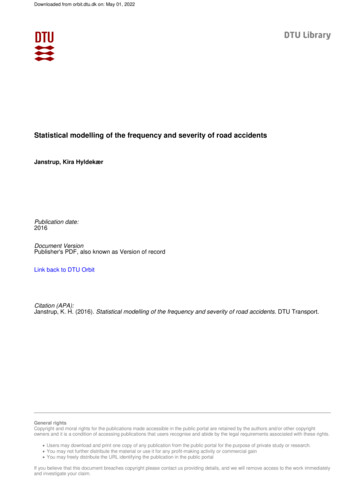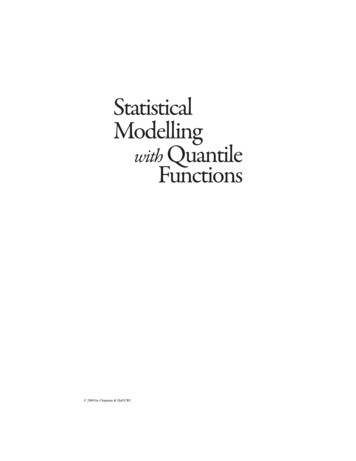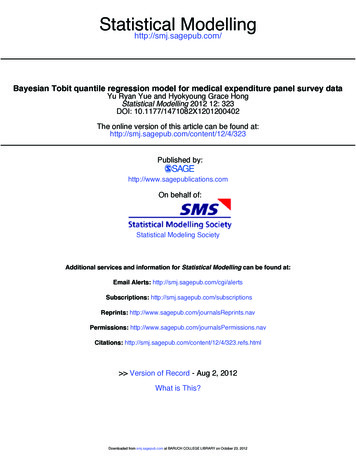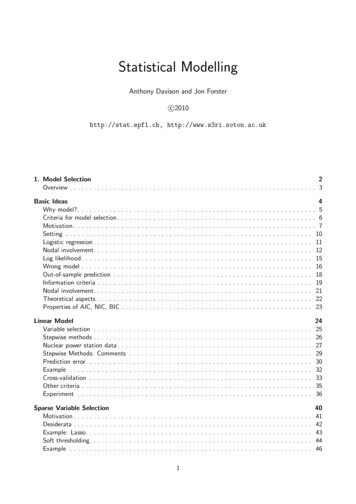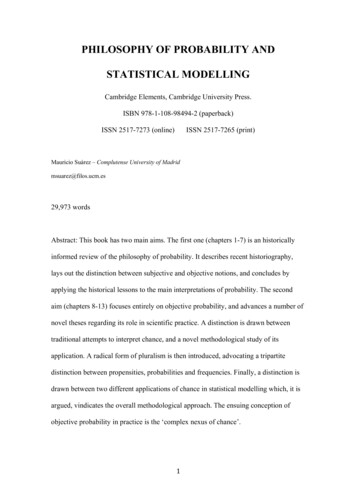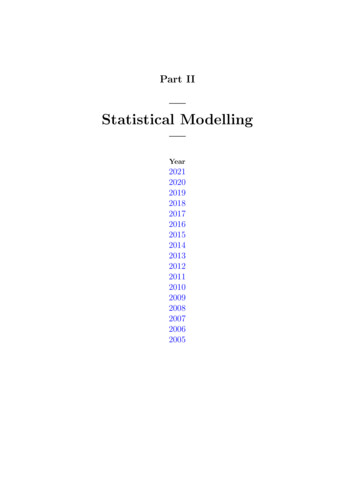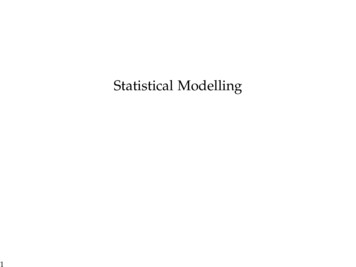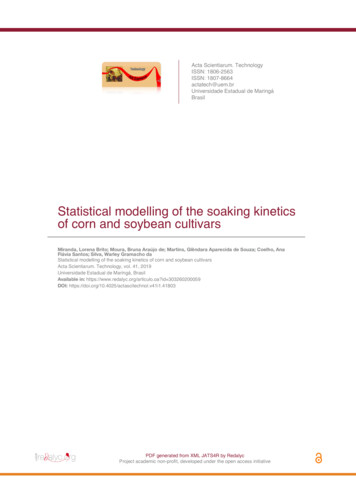
Transcription
Acta Scientiarum. TechnologyISSN: 1806-2563ISSN: 1807-8664actatech@uem.brUniversidade Estadual de MaringáBrasilStatistical modelling of the soaking kineticsof corn and soybean cultivarsMiranda, Lorena Brito; Moura, Bruna Araújo de; Martins, Glêndara Aparecida de Souza; Coelho, AnaFlávia Santos; Silva, Warley Gramacho daStatistical modelling of the soaking kinetics of corn and soybean cultivarsActa Scientiarum. Technology, vol. 41, 2019Universidade Estadual de Maringá, BrasilAvailable in: https://www.redalyc.org/articulo.oa?id 303260200059DOI: PDF generated from XML JATS4R by RedalycProject academic non-profit, developed under the open access initiative
Lorena Brito Miranda, et al. Statistical modelling of the soaking kinetics of corn and soybean cul.Ciência, Tecnologia de Alimentos e Engenharia de AlimentosStatistical modelling of the soaking kinetics of corn and soybean cultivarsLorena Brito MirandaUniversidade Federal do Tocantins, Brasillorenabritom@gmail.comDOI: Redalyc: https://www.redalyc.org/articulo.oa?id 303260200059Bruna Araújo de MouraUniversidade Federal do Tocantins, BrasilGlêndara Aparecida de Souza MartinsUniversidade Federal do Tocantins, BrasilAna Flávia Santos CoelhoUniversidade Federal do Tocantins, BrasilWarley Gramacho da SilvaUniversidade Federal do Tocantins, BrasilReceived: 26 February 2018Accepted: 11 September 2018Abstract:Consumption of cereals and legumes o en requires that seeds are first hydrated to facilitate operations such as canning or cookingin order to decrease cooking time and increase the leaching of materials. is research aimed at evaluating the effect of temperatureand time on soaking kinetics of corn and soybean cultivars, and apply different statistical models to describe the process. Hydrationexperiments were performed in temperatures of 25, 35, 45, 55 and 65ºC. Studies on immersion in water showed that the absorptionrate was greater during initial phase of immersion and at higher temperatures. Peleg, Weibull and First-order kinetics modelsobtained the best fits to the experimental data. Weibull model is the one that best describes the soaking kinetics of corn andsoybean in the investigated temperatures.Keywords: Zea mays, Glycine max, water absorption, canned, models adjustments.IntroductionCereals and legumes are important dietary components, due to the fact that not only they contribute to thesupply of energy, protein and carbohydrates, but also, they have relevant levels of calcium, iron and zinc,essential minerals to the body and cellular metabolism (Barrueto-Gonzalez, 2008).According to Pastore, Oliveira, and Brumano (2014), the production of corn and soybeans have globaleconomic importance due to its diversity of use. ese grains are used from animal and human feeding tohigh-tech industry.Soaking corn and soybeans is an essential step in the production of traditional products such as, cannedcorn and soy milk. is process is used to change characteristics in the texture of grains and facilitate theextraction of antinutritional components as well (Pan & Tangratanavalee, 2003). e study of water absorption in grains is of great interest to the food industries, since the processingof grain requires that seeds are first hydrated to so en the cellular structure and reduce the cooking time,Author noteslorenabritom@gmail.comPDF generated from XML JATS4R by RedalycProject academic non-profit, developed under the open access initiative
Acta Scientiarum, 2019, vol. 41, January-December, ISSN: 1806-2563 1807-8664decrease losses and make operations such as canning and extraction of constituents easier (Wang, Swain,Hesseltinehd, & Heath, 1979; Maskan, 2002).Statistical models are important tools for design and optimization of dehydration and soaking processes(Ansari, Ma oon-Azad, Hosseini, Farahnaky, & Asadi, 2015). According to Resende and Corrêa (2007),these tools are essential to simulate the behavior of materials subjected to the hydration process, being ableto use theoretical and empirical models.Among various models proposed to describe the food soaking kinetics, empirical equations are frequentlyused because they are simpler and easier to apply, since it is based on experimental data and dimensionalanalysis, as well as statistical analysis (Botelho, Corrêa, Goneli, Martins, & Baptestini, 2010; Cox, Gupta, &Abu-Ghannam, 2012). e objective of this work was to study the soaking kinetics of corn and soybeans by applying empiricalmodels such as the Peleg, Weibull, First-order Kinetic and Exponential.Material and methodsSix grain cultivars were used: three cultivars of corn (UFT-1, UFT-2, UFT-3) donated by GeneticImprovement Program from UFT and three commercial soybean cultivars (M8766, M9144, BRS 33871)grown in Tocantins. Strange materials, broken and small grains were removed. e initial moisture content(decimal dry basis) of the samples was obtained by the stove method, 105 1 C for 24 hours in threerepetitions, until constant mass (AOAC, 1995).For immersion tests, grains were soaked in distilled water (1:6 ratio of grain to water) (Bayram, Kaya, &Oner, 2004), and taken to the water bath, TECNAL TE-0541 model, at controlled temperatures of 25, 35,45, 55 and 65 C for 12 hours. e soaking tests were performed in triplicates for each temperature. e grains were removed from beakers, for approximately two minutes, and put over filter papers toeliminate water excess every 90 min. A er that, they were weighed and put back to soaking (Resende &Corrêa, 2007). e moisture content for a given time a er the beginning of the experiment was calculated based on themass increase of samples in relation to initial mass. e four most commonly described in the literature empirical models were used to describe the kinetics ofwater absorption of the samples, namely: Peleg, Weibull Distribution, First-order Kinetic and ExponentialModel.Peleg’s model is represented by Equation 1, where C1 and C2 refer to model constants (Peleg, 1988):(1)where:Ut is the moisture content at time t, (decimal d.b.), U0 is the initial moisture content (decimal d.b.), t isthe soaking time (min.), C1 is the Peleg rate constant (min decimal d.b.-1) and C2 is Peleg capacity constant,(decimal d.b.-1). For a sufficiently long time of hydration, equilibrium moisture (Ueq) can be obtained byEquation 1 when the time tends to infinity resulting in Equation 2:PDF generated from XML JATS4R by RedalycProject academic non-profit, developed under the open access initiative
Lorena Brito Miranda, et al. Statistical modelling of the soaking kinetics of corn and soybean cul.(2)In the Weibull distribution model, Ueq is considered as an additional parameter to be calculated (Weibull,1939). en, the Weibull Model is described as Equation 3:(3)where:α and β are the shape (dimensionless) and scale parameters (min.), respectively. e first-order kinetic model is based on the diffusion model of second Flick’s law for different geometriesand is expressed as follows (Krokida & Marinos-Kouris, 2003) Equation 4:(4)where: e model constant, k1, is the soaking rate (min. decimal d.b.-1).Exponential model is represented by Equation 5. k2 is the constant model (min. decimal d.b.-1; Cox et al.,2012).(5) e parameters of the models were estimated by performing a nonlinear regression by least squaresmethod, with the aid of the STATISTICA 7.0 so ware system (Statso , 2004). e degree of fit for each model considered the value of determination coefficient (R2), values of meanrelative error (P) and estimated standard error (SE) were calculated by the following Equation 6 and 7:(6)(7)where:PDF generated from XML JATS4R by RedalycProject academic non-profit, developed under the open access initiative
Acta Scientiarum, 2019, vol. 41, January-December, ISSN: 1806-2563 1807-8664Y is value experimentally observed, is value calculated by the model, n is soaking number of experimentalobservations, GLR is degree of freedom of model (number of observations minus number of modelparameters).Results and discussion e kinetics of the moisture content of corn and soybean as a function of soaking time are shown in Figure1. Corn and soybean cultivars showed similar behavior among each group in relation to grain soakingkinetics, and the format of the hydration curves shown is typical of agricultural products, in which there isan exponential trend with high water absorption rates in the beginning of the process. However, as time ofhydration increases, grain moisture tends to equilibrium (Ansari et al., 2015, Vengaiah, Raigar, Srivastav, &Majumdar, 2012).According to Bello, Tolaba, and Suarez (2004), Botelho et al. (2010) and Resende and Corrêa (2007), thequick rise of water absorption in the initial phase of hydration is mainly due to natural capillarity existent inouter layers of grains, and also by the gradient difference between grain tissues and external environment.FIGURE 1.Soaking kinetics of corn and soybean cultivars as a function of temperature and hydration time.PDF generated from XML JATS4R by RedalycProject academic non-profit, developed under the open access initiative
Lorena Brito Miranda, et al. Statistical modelling of the soaking kinetics of corn and soybean cul.In hydration of corn grains (Figure 1), one can observe an increase in absorbed water content as itincreases the soaking temperature during the whole process, whereas for soybean this increase occurred inthe early hydration stages. is phenomenon can be connected to the high diffusion rate in water at a highertemperature.For soybean at temperatures above 35 C there was a decrease in water absorption a er the first hours ofhydration compared to lower temperatures (Figure 1). According to Toledo (2008), soybeans are extremelysusceptible to damage by soaking and can absorb water very quickly and cause breaks in their tissues, whichis likely to have happened at temperatures of 45, 55 and 65 C a er the first hours of hydration, leadingto a decrease of water absorption, agreeing with Quicazán, Caicedo, and Cuenca (2012), when analyzingsoybeans hydration observed that hydration rate at 80 C was lower than at 40 C.In order to describe the hydration kinetics of corn and soybean, four experimental models were applied.Table 1 and 2 show constants obtained from the used models and the predicted values of the equilibriummoisture (Ueq). e values of the constant C1Peleg’s model decreased with the increase of temperature indicating thatthere is a higher rate of water absorption at higher temperatures for the studied grains. Similar behavior wasfound by other authors (Kashiri, Kashaninejad, & Aghajani, 2010; Vengaiah et al., 2012).TABLE 1.Estimated parameters of Peleg’s Model, Weibull, First-order kineticsand Exponential applied to the hydration kinetics of corn cultivars.PDF generated from XML JATS4R by RedalycProject academic non-profit, developed under the open access initiative
Acta Scientiarum, 2019, vol. 41, January-December, ISSN: 1806-2563 1807-8664TABLE 2.Estimated parameters of Peleg’s Model, Weibull, First-order kineticsand Exponential applied to the hydration kinetics of soybean cultivars.According to Khazaei and Mohammadi (2009), the constant C2 of the Peleg’s model is inversely relatedto the absorption ability of foods. For soybean, the constant C2 (Table 2) increased as the temperature wasraised. is can be explained by the fact that soybeans soaked at a high temperature from the first hours ofhydration begin to suffer physical changes in its structure, reducing the ability to absorb water.To cultivars of corn, constant C2 (Table 1) was not dependent on the hydration temperature, agreeingwith Sopade and Obekpa (1990). e authors point out that this fact can be explained when, during thehydration, there is not a considerable loss of solids with increasing temperature, and C2 constant becomesan independent variable of temperature.Table 1 and 2 also show values of the parameters α and β from the Weibull model. e constant α did notpresent linear temperature dependence for all corn grains and soybean studied, agreeing with the what wasfound by Ansari et al. (2015). e constant β represents the time required for grains to reach approximately 63% of the total absorptioncapacity (Machado, Oliveira, & Cunha, 1999) and in this study the β values decrease as the temperatureincreases. is dependence is in line with what was observed by Machado et al. (1999) and Ansari et al.(2015).Constants of the first-order kinetic model (k1) and the Exponential Model (k2) increased with theelevation of hydration temperature for corn grains and soybean. Similar dependence was found by Yildirim,Bayram, and Öner (2012), studying chickpeas, and by Ajala and Ajala (2015), with green banana chips.According to Ansari et al. (2015), the greater the values of k1 and k2, the larger the hydration speed.In relation to the effect of temperature on equilibrium Moisture content, Ueq, predicted values from thefour models decreased with increasing temperature to soybean, disagreeing with studies conducted withbeans (Abu-Ghannam & Mckenna, 1997) and chickpeas (Turhan, Sayar, & Gunasekaran, 2002; Yildirim etal., 2012).One of the explanations can be due to the occurrence of loss of soluble solids to the extent that itincreases the hydration temperature (Abu-Ghannam & Mackenna, 1997). ere was no dependency between the equilibrium moisture content and temperature of soaking for corngrain. Peleg’s model presented Ueq values higher when compared to other models for corn and soybean, inline with Ansari et al. (2015) studies.Values of the coefficients of determination, mean relative error and estimated standard error for the fourmodels adjusted during the hydration of corn grains and soybean are shown in Table 3 and 4.PDF generated from XML JATS4R by RedalycProject academic non-profit, developed under the open access initiative
Lorena Brito Miranda, et al. Statistical modelling of the soaking kinetics of corn and soybean cul.According to Mohapatra and Rao (2005) and Cunningham, McMinn, Magee, and Richardson (2007),high values of the determination coefficient (higher than 79%, in a comparison scale from 0 to 100%) andreduced the standard error of estimate values (near zero) and the mean relative error (less than 10%) indicatea satisfactory fit of the model to experimental data.It can be observed that models of Peleg, Weibull and First-order showed a good fit to experimental dataobtained reduced SE and P values and R² values greater than 97 and 89% for corn and soybean, respectively(Table 3 and 4). e Exponential model presented SE values higher than other models, P values above 11%and R² between 70 to 96% for the corn grains and 97 to 99% for soybean, not indicating a satisfactory fitof the model, and agreeing with Ajala and Ajala (2015), where the Exponential model obtained the lowestvalue of R2 (65%) among other models studied for soaking of green banana chips.According to the correspondence graphics between the values of the water content, experimental andestimated by models (Figure 2), Weibull model was considered the best fit to the experimental data, it hadthe lowest standard error values estimate (SE), for all the cultivars of corn and soybean, followed by the modelof the First-order, Peleg and Exponential.Authors such as Cunningham et al. (2007) and Ansari et al. (2015) also reported great fit of the Weibullmodel. Peleg’s model and Weibull were the most accurate to describe the water absorption of almond(Khazaei, 2008).PDF generated from XML JATS4R by RedalycProject academic non-profit, developed under the open access initiative
Acta Scientiarum, 2019, vol. 41, January-December, ISSN: 1806-2563 1807-8664FIGURE 2.Correspondence between experimental and estimated values for four models atdifferent temperatures during the soaking of corn and soybean cultivars studied.PDF generated from XML JATS4R by RedalycProject academic non-profit, developed under the open access initiative
Lorena Brito Miranda, et al. Statistical modelling of the soaking kinetics of corn and soybean cul.TABLE 3.Statistical indexes for modeling hydration of corn grains in different temperature conditions.TABLE 4.Statistical indexes for modeling hydration of soybean grains in different temperature conditions.ConclusionPeleg’s model, Weibull model and First-order kinetic model are those to best describe the soaking kineticsof corn and soybean, however Weibull model obtains the best fit compared to the others, in the immersionconditions studied by this project.AcknowledgementsTo CNPq (Conselho Nacional de Desenvolvimento Científico e Tecnológico) for the first author’s awardedscholarship.PDF generated from XML JATS4R by RedalycProject academic non-profit, developed under the open access initiative
Acta Scientiarum, 2019, vol. 41, January-December, ISSN: 1806-2563 1807-8664ReferencesAbu-Ghannam, N., & Mckenna, B. (1997). Hydration kinetics of red kidney beans (Phaseolus vulgaris L.). Journal ofFood Science, 62(3), 520-523. doi: 10.1111/j.1365-2621.1997.tb04420.xAjala, A. S., & Ajala, F. A. (2015). Water absorption characteristics and modelling of unripe plantain chips.International Journal of Scientific & Engineering Research, 6(5), 29-37.Ansari, S., Ma oon-Azad, N., Hosseini, E., Farahnaky, A., & Asadi, G. (2015). Modeling the rehydration behavior ofdried figs. Journal of Agricultural Science and Technology, 17(1), 133-144.Association of Official Analytical Chemists [AOAC]. (1995). Official methods of analysis (16th ed.). Washington,DC: AOAC.Barrueto-Gonzalez, N. B. (2008). Biodisponibilidade de minerais das fontes leguminosas. Revistasimbio-logias, 1(1),174-183. doi: 10.32905/1983-3253/2008.01.01p174Bayram, M., Kaya, A., & Oner, M. D. (2004). Changes in properties of soaking water during production of soy-bulgur.Journal Food Engineering, 61(2), 221-230. doi: 10.1016/S0260-8774(03)00094-3Bello, M., Tolaba, M. P., & Suarez, C. (2004). Factors affecting water uptake of rice grain during soaking. LebnsmittelWissenscha und Technologie, 37(8), 811-816. doi: 10.1016/j.lwt.2004.02.014Botelho, F. M., Corrêa, P. C., Goneli, A. L. D., Martins, M. A., & Baptestini, F. M. (2010). Análise dahidratação do arroz na parboilização. Ciência e Tecnologia de Alimentos, 30(3), 713-718. doi: 10.1590/S0101-20612010000300023Cox, S., Gupta, S., & Abu-Ghannam, N. (2012). Effect of Different rehydration temperatures on the moisture, contentof phenolic compounds, antioxidant capacity and textural properties of edible irish brown seaweed. LWT - FoodScience and Technology, 47(2), 300-307. doi: 10.1016/j.lwt.2012.01.023Cunningham, S. E., Mcminn, W. A. M., Magee, T. R. A., & Richardson, P. S. (2007). Modelling water absorption ofpasta during soaking. Journal of Food Engineering, 82(4), 600-607. doi: 10.1016/j.jfoodeng.2007.03.018Kashiri, M., Kashaninejad, M., & Aghajani, N. (2010). Modeling water absorption of sorghum during soaking. LatinAmerican Applied Research, 40(4), 383-388.Khazaei, J. (2008). Characteristics of mechanical strength and water absorption in almond and its kernel. CercetăriAgronomiceîn Moldova, 41(1), 37-51.Khazaei, J., & Mohammadi, N. (2009). Effect of temperature on hydration kinetics of sesame seeds (SesamumindicumL.). Journal of Food Engineering, 91(4), 542-552. doi: 10.1016/j.jfoodeng.2008.10.010Krokida, M. K., & Marinos-Kouris, D. (2003). Rehydration kinetics of dehydrated products. Journal of FoodEngineering, 57(1), 1-7. doi: 10.1016/S0260-8774(02)00214-5Machado, M. F., Oliveira, F. A. R., & Cunha, L. M. (1999). Effect of milk fat and total solids concentration onthe kinetics of moisture uptake by ready-to-eat breakfast cereal. International Journal of Food Science andTechnology, 34(1), 47-57. doi: 10.1046/j.1365-2621.1999.00238.xMaskan, M. (2002).Effect of processing on hydration kinetics of three wheat products of the same variety. Journal ofFood Engineering, 52(4), 337-341. doi: 10.1016/S0260-8774(01)00124-8Mohapatra, D., & Rao, P. S. (2005). A thin layer drying model of parboiled wheat. Journal of Food Engineering, 66(4),513-518. doi: 10.1016/j.jfoodeng.2004.04.023Pan, Z., & Tangratanavalee, W. (2003). Characteristics of soybeans as affected by soaking conditions. LebensmittelWissenscha und Technologie, 36(1), 143-151. doi: 10.1016/S0023-6438(02)00202-5Pastore, S. M., Oliveira, W. P., & Brumano, G. (2014). Mercado de milho, farelo de soja e ovos no Brasil de 2010-2013.Revista Eletrônica Nutri Time, 11(1), 2982-3006.Peleg, M. (1988). An empirical model for the description of moisture sorption curves. Journal of Food Engineering,53(4), 1216-1219. doi: 10.1111/j.1365-2621.1988.tb13565.xQuicazán, M. C., Caicedo, L. A., & Cuenca, M. (2012). Applying peleg's equation to modelling the kinetics of solidhydration and migration during soybean soaking. Ingeniería e Investigación, 32(3), 53-57.PDF generated from XML JATS4R by RedalycProject academic non-profit, developed under the open access initiative
Lorena Brito Miranda, et al. Statistical modelling of the soaking kinetics of corn and soybean cul.Resende, O., & Corrêa, P. C. (2007). Modelagem matemática do processo de hidratação de sementes de feijão. ActaScientiarum. Agronomy, 29(3), 373-378. doi: 10.4025/actasciagron.v29i3.387Sopade, P. A., & Obekpa, J. A. (1990). Modelling water absorption in soybean, cowpea and peanuts atthree temperatures using Peleg’s equation. Journal of Food Science, 55(4), 1084-1087. doi: 10.1111/j.1365-2621.1990.tb01604.xStatso Inc. (2004). Statistica: data analysis so ware system, version 7. Tulsa, OK: Statso Inc.Toledo, M. Z., Cavariani, C., França-Neto, J. B., & Nakagawa, J. (2010). Imbibition damage in soybean seeds as affectedby initial moisture content, cultivar and production location. Seed Science and Technology, 38(2), 399-408. doi:10.15258/sst.2010.38.2.13Turhan, M., Sayar, S., & Gunasekaran, S. (2002). Application of peleg model to study water absorption in chickpeaduring soaking. Journal of Food Engineering, 53(2), 153-159. doi: 10.1016/S0260-8774(01)00152-2Vengaiah, P. C., Raigar, R. K., Srivastav, P. P., & Majumdar, G. C. (2012). Hydration characteristics of wheat grain.Agricultural Engineering International: CIGR Journal, 14(1), 116-119.Wang, H. L., Swain, E. W., Hesseltinehd, C. W., & Heath, H. D. (1979). Hydration of whole soybeansaffects solids losses and cooking quality. Journal of Food Science, 44(1), 1510-1513. doi: 10.1111/j.1365-2621.1979.tb06474.xWeibull, W. A. (1939). Statistical theory of the strength of materials. Ingeniors Vetenskaps Akademien, 151(3), 45-55.Yildirim, A., Bayram, M., & Öner, M. D. (2012). Hydration kinetics of ultrasound treated chickpeas (Cider arietinuml.) during soaking. Journal of the Faculty of Agriculture, 16(4), 26-36.PDF generated from XML JATS4R by RedalycProject academic non-profit, developed under the open access initiative
PDF generated from XML JATS4R by Redalyc Project academic non-profit, developed under the open access initiative Acta Scientiarum. Technology ISSN: 1806-2563 ISSN: 1807-8664 actatech@uem.br Universidade Estadual de Maringá Brasil Statistical modelling

